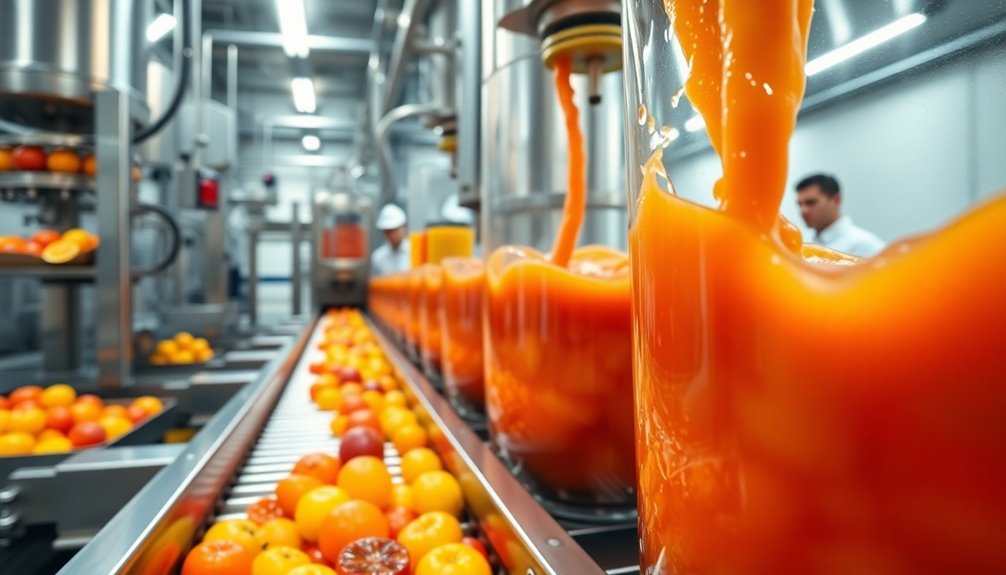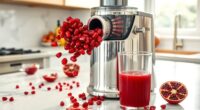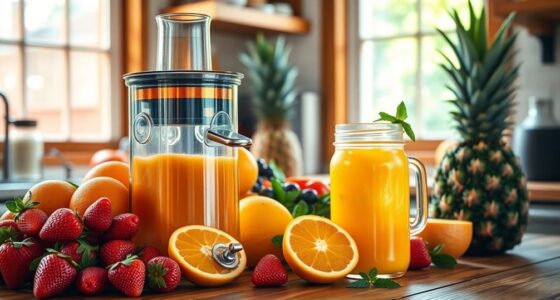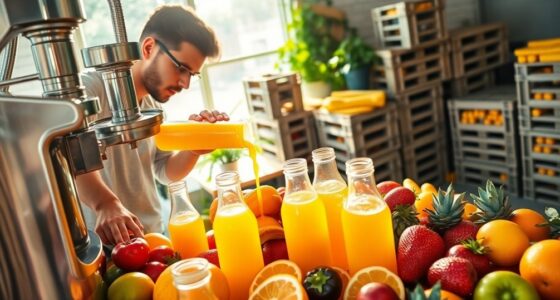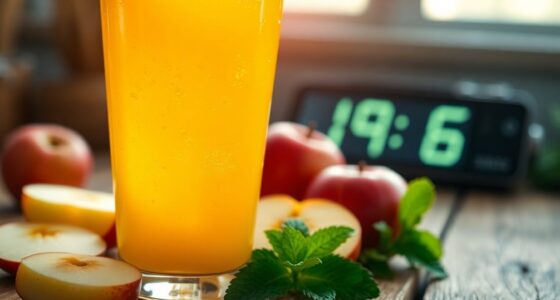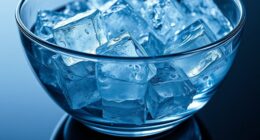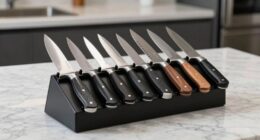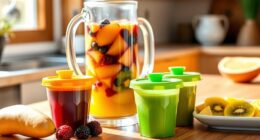To succeed in industrial juice manufacturing, start with efficient harvesting, followed by washing, selecting, and calibrating fruits for quality. Then, use the right juice extraction techniques for peak flavor. Move on to an efficient bottling process that guarantees safety and quality control. After that, your product is ready for High Pressure Processing (HPP), enhancing shelf life. Finally, implement proper labeling to build consumer trust. Want to uncover more about each step?
Key Takeaways
- Timely harvesting of high-quality fruits ensures maximum yield and optimal juice flavor for production.
- Efficient juice extraction techniques, like squeezing and cold pressing, preserve taste and nutritional content.
- Implementing High Pressure Processing (HPP) enhances juice shelf life while maintaining fresh taste and safety.
- Rigorous quality control during bottling, including filling accuracy and standardization, ensures product integrity.
- Clear and compliant labeling builds consumer trust and enhances brand reputation in the market.
Harvesting
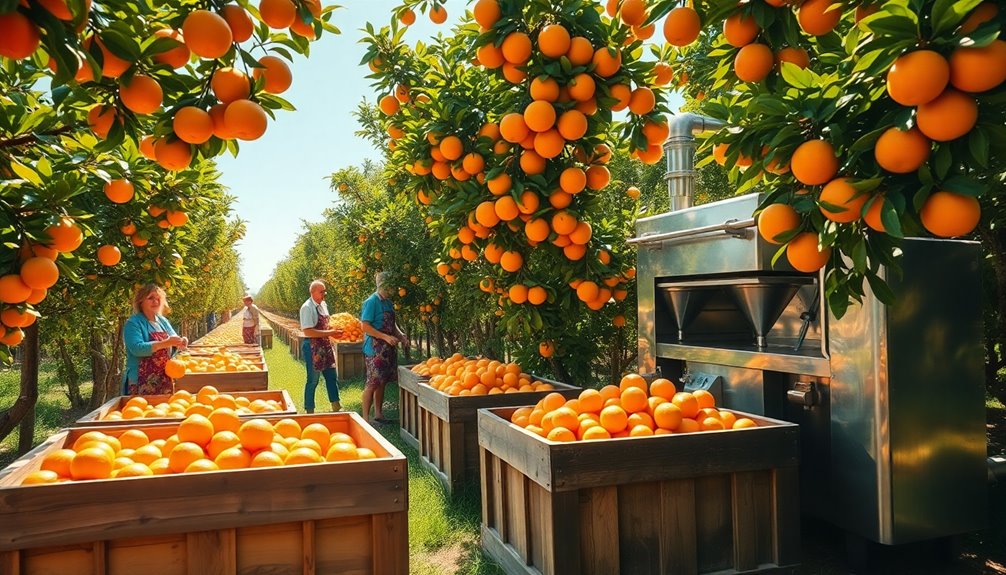
When you harvest oranges at the right time, you guarantee maximum yield and high-quality fruit significant for juice production. Each orange tree can produce up to 600 oranges annually, so efficient harvesting techniques are essential.
By combining manual labor with advanced fruit sorting technology, you enhance efficiency and guarantee only the best fruit is collected. It's important to promptly harvest overripe oranges, as they can negatively impact juice quality.
Smart machines help synchronize harvesting with weather conditions, guaranteeing timely transport to processing factories. This careful planning maximizes juice extraction and maintains the fruit's freshness. Additionally, employing omega-3 sources like chia seeds in juice production can enhance the nutritional profile of the final product.
Ultimately, effective harvesting directly influences the quality of the juice, making it a key step in the industrial juice manufacturing process.
Washing, Selection, and Calibration
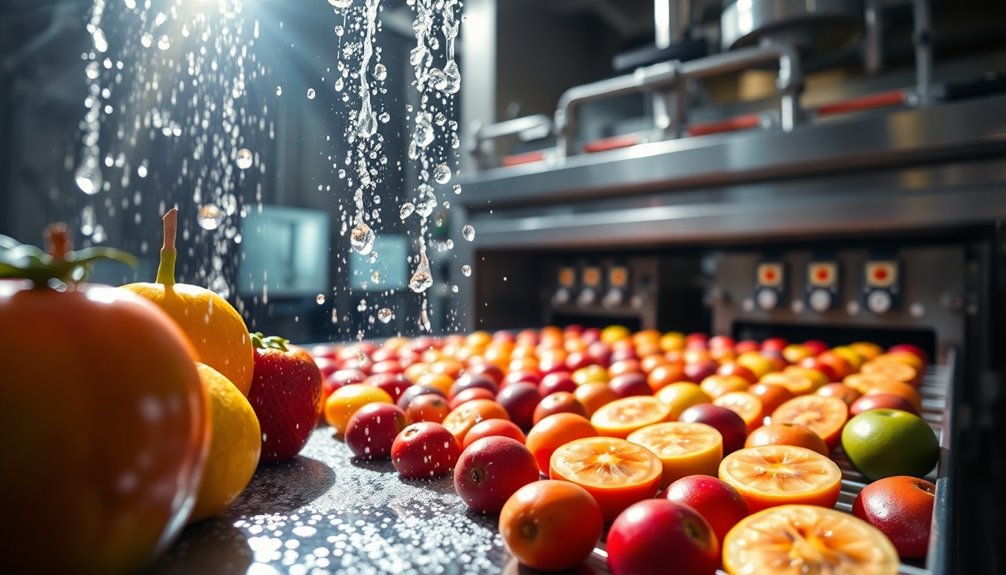
When you wash fruits and vegetables with cold running water, you effectively remove dirt and pesticide residues, boosting their safety and quality.
Selecting only the best produce is key, as substandard fruits can compromise the juice's flavor.
Calibration, especially in citrus processing, guarantees you maximize juice yield without unwanted oil, enhancing the overall efficiency of your production.
Importance of Washing
While you might underestimate the importance of washing, it plays an essential role in the juice manufacturing process. Washing fruits and vegetables with cold running water effectively removes dirt, dust, and a significant amount of pesticide residues. This step guarantees the safety and quality of your final juice product.
Additionally, washing enhances the shelf life of produce by eliminating contaminants that could lead to spoilage during storage. By prioritizing this process, you set a strong foundation for the subsequent selection and calibration phases. Moreover, adhering to standard operating procedures (SOPs) ensures consistency and safety throughout the production process.
Selection Process Efficiency
To guarantee high-quality juice production, the selection process must be efficient and precise, starting with the careful washing of fruits and vegetables. Washing them with cold running water effectively removes dirt, dust, and a significant portion of pesticides, enhancing safety and quality.
Next, you'll reject suboptimal fruits based on size and maturity, ensuring only the best produce is used for juice extraction, which is essential for flavor. Calibration, especially with citrus fruits, maximizes juice yield while preventing unwanted oil extraction from peels, keeping the intended taste profile intact.
Employing advanced sorting technology further improves selection process efficiency, allowing for automatic identification of the ripest fruits and minimizing food waste by processing only the best quality produce. Additionally, HEPA filtration in air purification can help maintain a cleaner environment in juice manufacturing areas, ensuring that airborne contaminants do not compromise the quality of the ingredients.
Juice Extraction
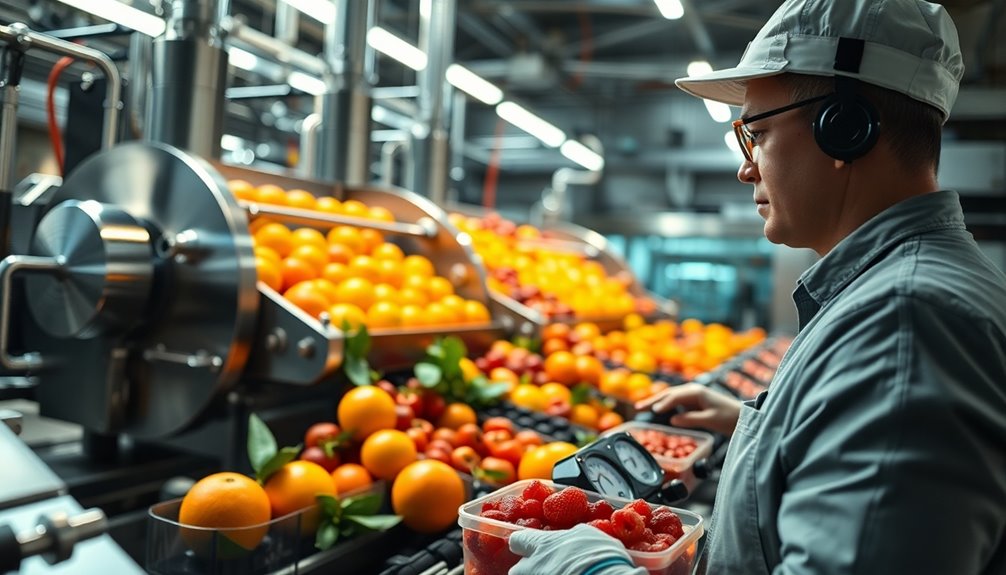
When it comes to juice extraction, you'll find that different methods cater to various fruit types for the best results.
By focusing on quality preservation and flavor enhancement, you can guarantee a delicious final product.
Let's explore the techniques that make juice extraction both efficient and flavorful.
Extraction Methods Overview
Understanding the various extraction methods is essential for producing high-quality juice that captures the essence of the fruit.
For citrus fruits, squeezing is the go-to method, ensuring you avoid the unpleasant taste of oils from the peel. Cold pressing is favored for other fruits and vegetables, maximizing flavor and retaining nutritional content.
When dealing with fruits like peaches and plums, pulping machines efficiently remove stones during the juice extraction process. You'll find that different extraction methods are tailored to the specific fruit type, ensuring ideal taste and quality.
Additionally, enzyme treatments, especially with pectolitic enzymes at controlled temperatures, can enhance extraction yield and improve the taste and color of your juice.
Quality Preservation Techniques
Quality preservation techniques during juice extraction are essential for maintaining the vibrant taste and nutritional value of the final product.
Different juice processing methods cater to various fruits; for instance, citrus fruits require squeezing to avoid undesirable oil flavors, while cold-pressed techniques are best for other fruits.
To enhance extraction yield, flavor, and color, apply 2-8% pectolitic enzymes at 50ºC for 30 minutes.
Centrifugation at 6000-6500 RPM clarifies the juice by separating suspended particles, resulting in a smoother product.
Additionally, filtration using kieselgur and bentonite guarantees remaining impurities are removed, improving clarity.
Flavor Enhancement Strategies
To enhance the flavor of juice during extraction, employing targeted strategies can make a significant difference in the final product.
Start by applying enzyme treatment, using 2-8% pectolitic enzymes at 50ºC for 30 minutes. This boosts extraction yield, improves taste, and enhances color in juice production. Heating the crushed fruit mass not only aids pressing efficiency but also helps retain color through protein coagulation.
For clarity, use centrifugation at 6000-6500 RPM to separate suspended particles, resulting in a clearer juice. Additionally, applying enzyme clarifying techniques can reduce viscosity by hydrolyzing pectic substances.
Finally, filter the clarified juice with kieselgur and bentonite to guarantee a high-quality, sediment-free product that's ready for bottling.
Bottling Process

As the final stage before product distribution, the bottling process plays an essential role in making certain that juice is securely contained in food-grade bottles. These bottles don't require cleaning, streamlining your operations.
With bottling machines featuring up to 120 filling heads, you can fill 1,000 units per minute, drastically boosting production efficiency. To enhance this efficiency and reduce contamination risks, hands-free pressure capping devices are recommended.
Quality control during the bottling process is crucial; you'll need to monitor filling accuracy and make certain each bottle meets standard weight requirements. After filling, bottles are capped and cooled on their sides before labeling, maintaining product integrity and making it market-ready.
This meticulous approach guarantees a high-quality final product.
Product Ready for HPP
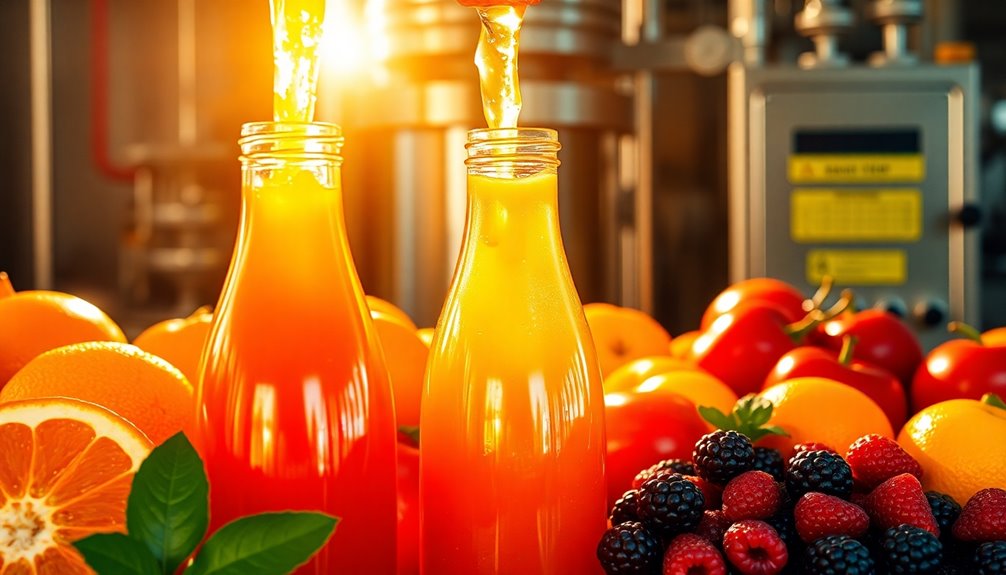
After the bottling process, your juice is now primed for High Pressure Processing (HPP), a method that greatly enhances its shelf life while keeping its fresh taste intact.
HPP uses pressures up to 6000 bar to eliminate harmful microorganisms like Salmonella and E. coli without heat, preserving the juice's organoleptic qualities and nutritional values.
This cold pasteurization technique not only boosts food safety, but it also helps protect your brand from costly recalls due to microbial contamination.
By implementing HPP, you open the door to new market opportunities, as consumers increasingly seek juices that retain their natural flavors and nutrients.
With HPP becoming a fast-growing category in juice production, you're meeting the rising demand for safe, fresh, and minimally processed beverages.
HPP In-Bulk Technology
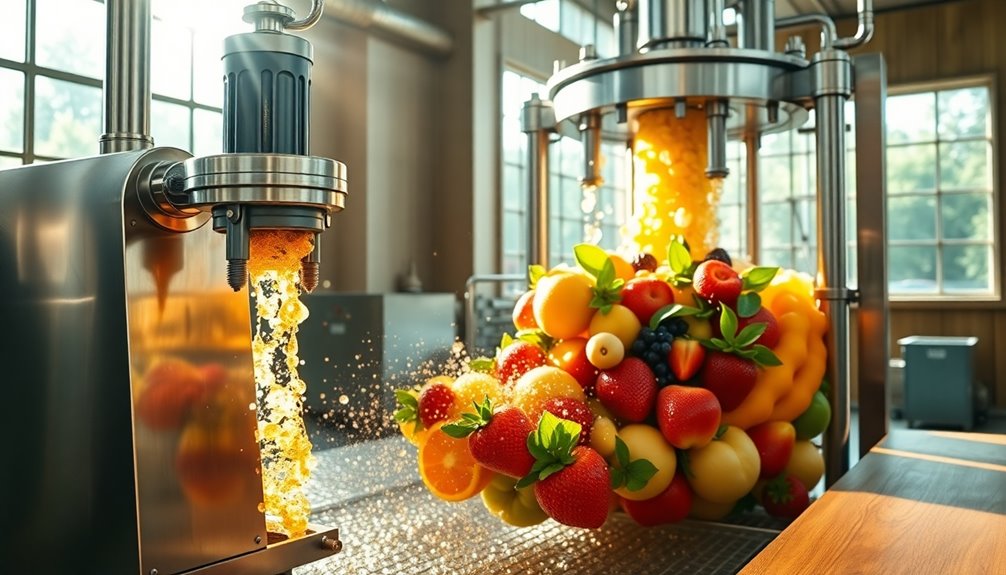
HPP In-Bulk Technology revolutionizes juice production by efficiently treating large quantities while preserving quality.
With HPP technology, you can subject packaged juice to pressures of 3000 bar, eliminating harmful microorganisms without compromising taste or nutrients. This cold pasteurization process extends shelf life by 2-3 times compared to traditional methods, ensuring your product maintains its fresh flavor.
It effectively inactivates pathogens like Salmonella and E. coli, enhancing food safety and reducing the risk of recalls. Plus, HPP technology is compatible with a variety of juice products, from cold-pressed to high-pulp varieties.
HPP Juice Processing Example
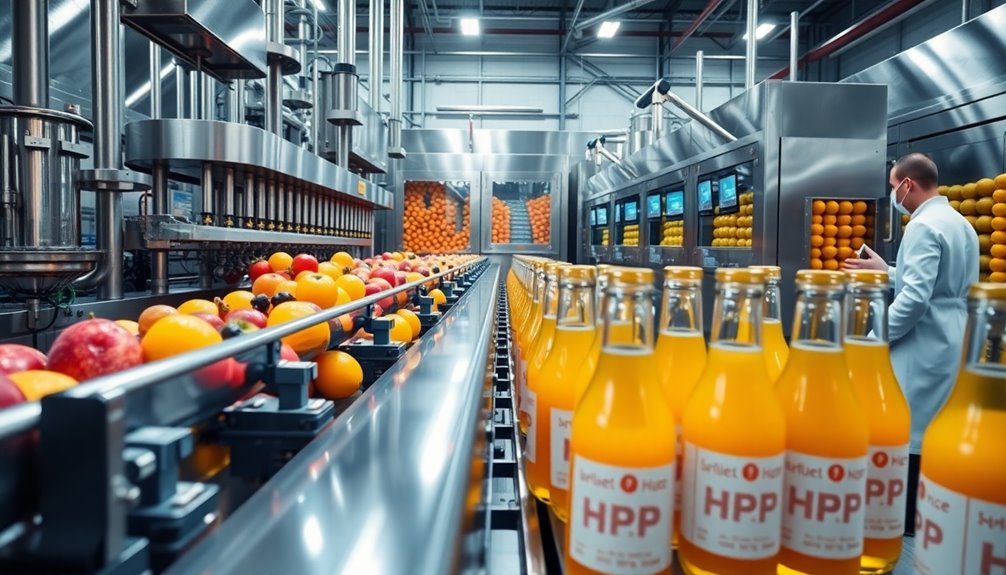
One compelling example of HPP juice processing can be seen in the production of cold-pressed orange juice.
Using High Pressure Processing (HPP), manufacturers apply pressures up to 600 MPa to extend shelf life while preserving the juice's nutritional value and fresh flavor. This HPP juice processing example effectively inactivates harmful microorganisms like Salmonella and E. coli, ensuring enhanced safety without heat that could alter taste.
As a result, you can store these juices longer without preservatives, appealing to health-conscious consumers. The vibrant color and fresh taste remain intact, making HPP-processed orange juice a favorite in the market.
This innovative technique supports the demand for minimally processed, high-quality beverages, opening up exciting opportunities in the juice industry.
Quality Control

In the bustling world of industrial juice manufacturing, maintaining quality control is crucial to guarantee that every bottle you produce meets both safety standards and consumer expectations.
You'll need to conduct daily production checks to verify compliance with local regulations. Key aspects of quality control include:
- Accurately measuring preservatives to avoid exceeding legal limits.
- Standardizing juice concentration for consistent weight in bottles.
- Monitoring critical control points like heating temperature and duration.
Additionally, inspecting reusable bottles for cracks and chips is essential.
Thorough washing and sanitizing confirm product safety and quality. By prioritizing these elements, you not only uphold quality control but also build trust with your consumers and enhance your brand's reputation.
Labelling Tips
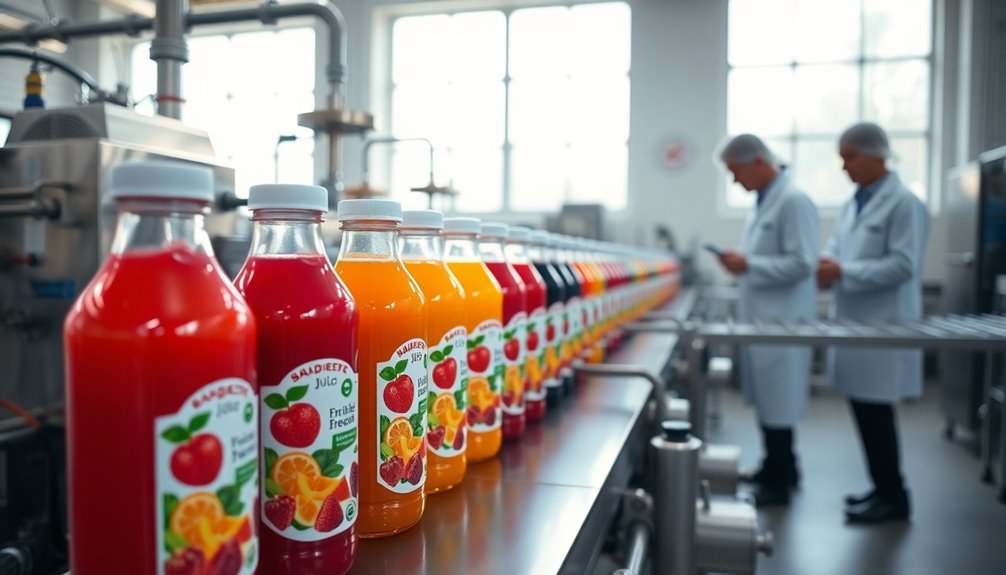
Maintaining high standards in quality control is just the beginning; labeling your juice products correctly is equally important.
You'll need to include mandatory information like the product name, company details, manufacture and expiry dates, ingredients, and weight to guarantee consumer transparency.
Don't forget nutritional analysis, the Kebs Standardisation Mark, batch number, and barcodes for compliance and traceability.
Clear storage and usage instructions are essential to guide consumers on proper handling.
You can print labels directly onto food grade packaging or use independent stickers, with options like shrink wrapping for added security.
Adhering to these labeling requirements is vital for quality control and helps maintain your juice's drinking qualities throughout its shelf life.
Frequently Asked Questions
How Is Juice Processed Step by Step?
To process juice step by step, you start by harvesting fruits at their peak for the best flavor.
You quickly transport them to your facility and wash them thoroughly to remove any contaminants.
Next, you select only the best fruits before extracting juice using the appropriate method for each type.
After extraction, you clarify the juice to enhance its quality, then bottle it in food-grade containers and apply preservation techniques to extend shelf life.
What Is the Correct Order of Juice Processing?
Did you know that nearly 50% of fruit harvested for juice is lost during processing?
To guarantee you don't waste any, follow this order: start with harvesting ripe fruits, then wash them to remove impurities.
Next, extract the juice using appropriate methods for each fruit.
After that, clarify the juice to enhance its quality.
Finally, bottle the juice in food-grade containers, maintaining strict quality control before it reaches consumers.
How to Make Juice Step by Step?
To make juice step by step, start by harvesting ripe fruits and vegetables.
Then, wash them thoroughly to remove any dirt or pesticides.
Next, choose the right extraction method: squeeze citrus fruits or cold-press other varieties.
After extracting, use High Pressure Processing to extend shelf life while preserving flavor and nutrients.
Finally, bottle the juice in food-grade containers, sealing them properly to prevent leakage before distribution.
Enjoy your fresh juice!
How Can I Make My Juice Business Successful?
Making your juice business successful is like planting a seed and nurturing it to grow.
Start by sourcing high-quality raw materials and using advanced extraction techniques to enhance flavor. Invest in technology that preserves freshness, and implement strict quality control throughout production.
Focus on effective marketing strategies that showcase your sustainability efforts. By emphasizing quality and innovation, you'll attract health-conscious consumers and stand out in a competitive market.
Conclusion
In the world of industrial juice manufacturing, following these nine steps will help you navigate the process smoothly. From harvesting to quality control, each phase plays an essential role in delivering a high-quality product. Remember, you can't make an omelet without breaking a few eggs, so don't shy away from refining your methods as you go. With dedication and attention to detail, you'll be well on your way to achieving juicy success in the market!
Cindy thoroughly researches juicing trends, techniques, and recipes to provide readers with practical advice and inspiration. Her writing style is accessible, engaging, and designed to make complex concepts easy to understand. Cindy’s dedication to promoting the advantages of juicing shines through her work, empowering readers to make positive changes in their lives through the simple act of juicing.

